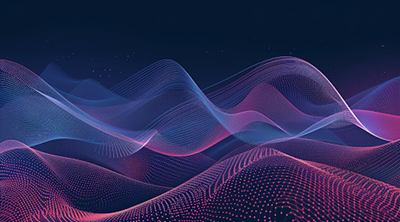Mastering Content Distribution in a Saturated Digital Landscape


The Seismic Shift
We are witnessing a seismic shift in content creation and distribution. This transformation is rewriting the rules of engagement, ushering in an era of hyper-personalization that presents marketers with immense opportunities and formidable challenges.
In this article, we'll:
- Examine key statistics revealing the current state of content saturation
- Explore effective strategies for cutting through the digital noise
- Project current trends into a future where AI-driven personalization dominates
- Offer insights on how marketers can adapt and thrive in this evolving landscape
From the staggering volume of daily content uploads to the rise of AI-generated media, we're entering uncharted territory. Join us as we navigate the topography of this shifting content distribution landscape and uncover how to make your message resonate in an increasingly crowded digital world.
The Content Deluge: Unprecedented Levels of Creation
The volume of content uploaded to the internet each day is truly staggering:
- Every minute, 500 hours of video is uploaded to YouTube.[1]
- Facebook generates 35 million status updates per minute[2]
- On X (formerly Twitter), 518 million tweets are posted daily.[3]
- TikTok users consume 1 billion video views daily.[4]
- WordPress hosts over 70 million new posts each month. [5]
- A mind-boggling 361.6 billion emails are sent and received every day. [6]
And this only scratches the surface. When we factor in streaming video and music platforms, website visits, mobile app usage, and the myriad of smaller networks populating the web, it becomes clear: We live in a world saturated to its silicon core with media—and every day, we add more.
The Marketer's Challenge
In this content-rich environment, content creators and marketers face a daunting challenge: How can their message cut through the noise and reach their intended audience? The answer lies not just in creating compelling content but also in distributing it effectively.
First, let’s examine some of the key trends in 2024. We’ll examine what the market is doing and get a bird’ s-eye view of the landscape. Then, we’ll examine the emergent trends to see the changes taking place and understand where the market is and where it might be going.
1. Understanding Content Distribution
Content distribution lets you share your content across various channels to reach your target audience. It's how you connect your message with the people who need to see it.
There are three main categories:
- Owned media: Channels you control. Your website, blog, and social profiles.
- Earned media: External channels where others share your content, including social media shares or press coverage.
- Paid media: Channels where you pay for visibility, such as sponsored content and pay-per-click advertising.
Recent stats highlight the importance of a well-rounded content distribution strategy:
- 90% of content marketers rely on social media.
- 79% have an active blog.
- 73% use email newsletters.
- 63% use paid channels to accelerate distribution. (Source)
2. Developing an Effective Content Distribution Plan
Crafting a successful content distribution plan requires a strategy:
Identify Your Target Audience
Understanding who your audience is and what they want is crucial. For example, if you're targeting B2B audiences, LinkedIn might be your primary platform, as 84% of B2B marketers say it currently delivers the best value over other social platforms.
Set Clear Distribution Goals
Whether it's increasing brand awareness, driving website traffic, or generating leads, having clear, measurable goals will guide your distribution efforts and help you gauge success.
Choose the Right Channels
Select channels that align best with your audience and goals. Select channels that align with your audience's preferences and your brand's capabilities. For instance, video content is in high demand, with 89% of customers expressing interest in more brand videos in 2024
Create a Content Calendar
Consistency is key in content distribution. A content calendar helps you plan what to publish, when, and where, ensuring a steady stream of content across your chosen channels
3. Use Different Distribution Strategies
Owned Media Strategies:
- Website and Blog: Optimize your blog for conversational search and implement internal linking strategies to improve content visibility and user engagement.
- Email Marketing: Use email for direct communication. Personalized emails can increase revenue by up to 760%, and automated emails can generate 320% more revenue.
- Social Media Platforms: Tailor content for each platform and engage actively with your audience. For instance, consider that 83% of Instagram users discover new products or services on the platform.
Earned Media Strategies
- Influencer Partnerships: Collaborate with influencers to reach new audiences. Micro-influencers often have highly engaged audiences and can be extremely cost-effective.
- User-Generated Content: Encourage your audience to create content related to your brand—this provides social proof and increases engagement.
- PR and Media Outreach: A well-placed press release or guest article in a respected publication can boost your content's visibility and credibility.
Paid Media Strategies
- Social Media Advertising: Platforms like Facebook, Instagram, and LinkedIn offer highly targeted options based on demographics, interests, and behaviors.
- Pay-Per-Click (PPC) Advertising: Google Ads and Bing Ads allow for keyword targeting and display network placement.
- Native Advertising: Platforms like Outbrain and Taboola place content recommendations on high-traffic websites, often resulting in higher engagement rates than traditional display ads.

4. Embrace Video & Interactive Content
The rise of video is reshaping content distribution:
- 67% of marketers say videos have become more important in the last year.
- Short-form videos on platforms like TikTok, Instagram Reels, and YouTube Shorts dominate the content landscape, especially among younger audiences.
- Interactive content such as quizzes and polls is on the rise. Encouraging user participation can create more memorable experiences and increase the value of your content.
5. Leverage AI and Personalization
AI and personalization are revolutionizing content distribution:
- 83.2% of content marketers plan to use AI tools in 2024, a significant increase from 64.7% in 2023.
- AI-driven recommendation engines analyze user behavior and preferences to deliver personalized content suggestions, improving user engagement and satisfaction.
- Personalized content delivery, driven by AI and machine learning advances, tailors content to individual users based on their preferences and behaviors.
6. Measure and Analyze Your Success
To refine your distribution strategy, focus on metrics that align with your goals:
- Reach: How many people are seeing your content?
- Engagement: Are people interacting with your content (likes, comments, shares)?
- Conversions: Is your content driving desired actions (sign-ups, purchases)?
Leverage analytics tools like Google Analytics, social media insights, and email marketing metrics to gather data on your content's performance across different channels.
7. Future Trends and Emerging Technologies in Content Distribution
As we look towards 2025-2030, several key trends and technologies will reshape the content distribution landscape:
Deep Content Personalization
AI and machine learning will play a crucial role in personalizing content delivery. Advanced algorithms will analyze user behavior, preferences, and interactions and provide highly tailored content recommendations, enhancing user engagement and satisfaction.
Integration of AI and Automation
AI will not only distribute but also create and curate content including:
- Automated content generation tools producing high-quality articles, videos, and social media posts
- AI-powered chatbots and virtual assistants provide personalized content recommendations
- Predictive analytics anticipating user needs and optimizing content delivery strategies
Rise of Interactive and Immersive Content
Augmented Reality (AR) and Virtual Reality (VR) technologies will revolutionize content consumption by offering immersive experiences. Users will interact with content in new ways, such as:
- Virtual tours and interactive storytelling
- 3D product demonstrations
- Interactive videos allow users to influence the narrative
Mobile-First and Omnichannel Strategies
With most content consumption happening on mobile devices, content distributors will prioritize mobile-first strategies:
- Optimizing websites, emails, and ads for mobile viewing
- Ensuring fast loading times
- Implementing omnichannel presence for a seamless user experience across multiple platforms
Enhanced Data Privacy and Security
As data privacy concerns grow, content distributors will need to:
- Comply with stricter regulations such as GDPR and CCPA
- Build trust through transparent data practices
- Give users more control over their data
Evolution of Social Media Algorithms
Social media platforms will become more transparent about their algorithms, allowing content creators to understand how to optimize their content for visibility and engagement. Algorithms will increasingly prioritize high-quality, original content over clickbait and low-value posts.
Emerging Technologies
Several emerging technologies will significantly impact content distribution:
- 6G+ Technology: Enabling faster and more reliable internet connections, supporting seamless streaming of high-quality video content and AR/VR applications.
- Edge Computing: Reducing latency and improving content delivery performance, particularly for real-time applications like live streaming.
- Blockchain Technology: Offering a decentralized approach to content distribution, providing greater transparency and security in managing digital rights and tracking content usage.
- Quantum Computing: Revolutionizing data processing capabilities, leading to more complex and faster analysis of large datasets for improved content personalization.
- Internet of Things (IoT): Providing new opportunities for content distribution through smart homes, connected cars, and wearable devices.

8. Innovative Strategies for User-Generated Content (UGC)
User-generated content continues to be a powerful tool for engagement and building trust. Here are some innovative UGC strategies based on successful campaigns:
Product Showcases
Example: Apple's Shot on iPhone Challenge
- Origin: Launched in 2015 as a marketing campaign.
- Strategy: Users share their best photos taken with an iPhone.
- Impact: Generated over 29 million tags on Instagram.
- Key Takeaway: Use branded hashtags to collect user-generated content (UGC) and showcase product quality through real user experiences.
Personalization
Example: Spotify's Wrapped Campaign
- Strategy: Personalized annual summaries of users' listening habits.
- Engagement: Encouraged users to share their unique Wrapped stats on social media.
- Impact: Created strong emotional connections and widespread sharing among users.
- Key Takeaway: Personalize experiences to foster emotional connections and encourage user engagement and sharing. (Link)
Emotional Connection
Example: Amazon’s Christmas 2023 "Joy Ride" Campaign
- Storyline: The ad features three elderly friends sitting on a park bench, nostalgically observing children sledding.
- Plot Twist: One of the ladies orders a set of seat cushions for the trio, allowing them to rekindle their childhood sledding activities and recapture the joy of their youth.
- Music: An instrumental version of The Beatles' "In My Life."
- Impact: The campaign evokes emotions by highlighting themes of nostalgia, friendship, and the joy of reliving cherished memories.
- Key Takeaway: Stories that evoke emotions are more memorable and create a deeper connection with the audience.
Conclusion
The shifts in the content distribution landscape between now and the end of the decade will be seismic. Advancements in generative AI, machine learning, and immersive technologies will play a pivotal role.
Personalization, interactivity, and mobile optimization will be key drivers of engagement, while data privacy and security will remain critical concerns.
The future of content distribution lies in embracing these emerging technologies and trends while focusing on creating authentic, valuable content that resonates with audiences. By leveraging AI for personalization and automation, exploring immersive technologies like AR and VR, and implementing innovative UGC strategies, content creators and marketers can stay ahead of the curve and effectively engage their audiences in the years to come.
Remember, while technology will continue to evolve, the core principles of effective content distribution remain: understand your audience, create valuable content, choose the right channels, and continuously measure and optimize your efforts. By combining these fundamentals with cutting-edge technologies and strategies, you'll be well-positioned to succeed in the dynamic world of content distribution.

About the Author
Adam is an experienced marketing leader with a natural curiosity about human behaviour. He heads up Agility's marketing efforts, helping others discover and experience the easy to use CMS with insane support. A big believer of living in the moment, Adam doesn't want to see you wasting the precious time you have on this earth on clunky, outdated content management systems. He's been there. It wasn't pretty. Give Agility CMS a try and start enjoying your life while you rock your job and have less headaches. Learn more about Adam HERE
